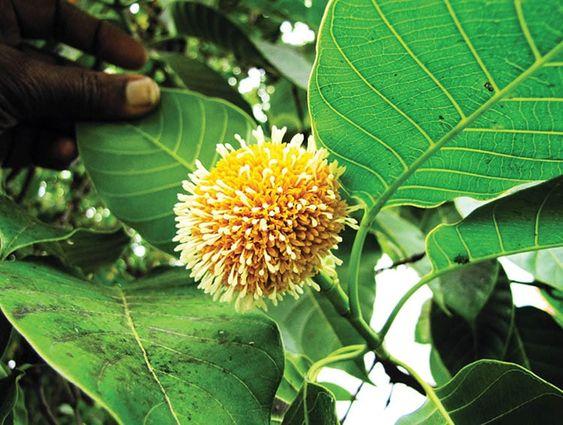



Table of Contents
- Introduction
- Botanical Characteristics
- Mythology and Symbolism
- Historical Context
- Medicinal Uses
- Economic Uses
- Growing Kadamba Trees
- Care and Maintenance
- Conclusion
- Faq's
Introduction
The Kadamba tree, scientifically known as Neolamarckia cadamba, is a remarkable species native to tropical regions of South and Southeast Asia. Renowned for its rapid growth, cultural significance, and ecological benefits, the Kadamba tree serves various purposes, from ornamental landscaping to medicinal uses. \This article delves into its botanical characteristics, cultural importance, care instructions, and flowering seasons.
 Kadam Flower
Kadam FlowerBotanical Characteristics
Description
The Kadamba tree is a majestic species that can reach impressive heights of up to 45 meters (approximately 148 feet). Its trunk can have diameters ranging from 100 to 160 cm, making it a prominent feature in any landscape. The bark of the Kadamba tree is typically gray and rough in older specimens, while younger trees exhibit a smoother texture that adds to their aesthetic appeal.
The glossy green leaves are oblong to elliptical in shape, measuring between 15-50 cm in length and 8-25 cm in width. They are arranged oppositely on the branches, creating a lush canopy that provides ample shade.
One of the most striking features of the Kadamba tree is its fragrant orange flowers, which bloom in dense spherical clusters. These flowers not only enhance the tree's beauty but also attract various pollinators such as bees and butterflies, playing a crucial role in the local ecosystem.
Habitat
Kadamba trees thrive in warm, humid climates and prefer well-drained, fertile soils. They are often found along riverbanks and in secondary forests, particularly in alluvial sites that are periodically flooded.
This adaptability allows them to flourish in diverse environments, making them a popular choice for urban landscaping and reforestation projects. The tree's extensive root system helps prevent soil erosion while stabilising riverbanks and other vulnerable areas.
In addition to their ecological benefits, Kadamba trees also contribute to biodiversity by providing habitat for various species of birds and insects. Their ability to grow rapidly makes them an excellent choice for restoring degraded lands, enhancing both soil quality and overall ecosystem health. As such, the Kadamba tree is not only a beautiful addition to any landscape but also plays an essential role in maintaining ecological balance.
Ecological Importance
The Kadamba tree contributes significantly to its environment through various ecological functions. One of its primary roles is soil improvement; the decomposition of fallen leaves enhances soil quality by increasing organic carbon levels and nutrient availability. This natural process enriches the soil, making it more fertile for other plants and contributing to overall ecosystem productivity. Additionally, the Kadamba tree serves as a shade provider, frequently planted along roadsides and in urban areas to offer respite from the sun's heat. Its broad canopy not only provides shade but also helps regulate local temperatures, contributing to urban cooling effects that can mitigate heat island phenomena common in densely populated areas.
Furthermore, the Kadamba tree plays a vital role in reforestation efforts due to its fast growth rate and adaptability. It can quickly establish itself in degraded lands and contribute to restoring biodiversity by providing habitat for various flora and fauna. The tree's flowers attract pollinators like bees and butterflies, promoting cross-pollination among nearby plants. This interdependence enhances local biodiversity and supports healthy ecosystems. In summary, the Kadamba tree's ecological importance cannot be overstated; it improves soil health, provides shade, supports biodiversity, and aids reforestation efforts.
Mythology and Symbolism
The Kadamba tree holds a revered place in Indian culture and mythology. It is often associated with Lord Krishna, who is said to have played under its shade during his childhood in Vrindavan. This connection imbues the tree with spiritual significance; it symbolises love and wisdom qualities epitomised by Krishna himself. The Kadamba tree is frequently referred to as the "Tree of Love" due to its association with Kamadeva, the god of love in Hindu mythology. Its fragrant flowers are believed to evoke feelings of romance and devotion, making it a popular choice for gardens dedicated to love or spirituality.
 Kadamba Tree is often linked with Sri Krishna
Kadamba Tree is often linked with Sri Krishna
In addition to its connection with deities, the Kadamba tree is linked with enlightenment; it is said that Gautama Buddha attained enlightenment beneath a Kadamba tree during his journey towards spiritual awakening. This association further enhances its status as a symbol of wisdom and spiritual growth across various cultures. The cultural significance of the Kadamba tree extends beyond religious contexts; it has been celebrated in poetry, art, and folklore throughout history. Its presence in gardens and temples serves as a reminder of nature's beauty and its deep-rooted connections to human emotions and experiences.
Historical Context
The historical context of the Kadamba tree adds another layer of significance to its cultural importance. The Kadamba dynasty (345-525 CE), which ruled parts of South India, derived its name from this majestic tree. This dynasty was known for its contributions to art, architecture, and literature during a time when Indian culture was flourishing. The prominence of the Kadamba tree during this period underscores its importance not just as a natural resource but also as a symbol of cultural identity.
Various ancient texts reference the Kadamba tree, highlighting its longstanding significance in Indian traditions. For example, it appears in classical literature such as "Mahabharata" and "Ramayana," where it is often depicted as a setting for romantic encounters or spiritual quests. The enduring legacy of the Kadamba tree can be seen today in many temples dedicated to Lord Krishna or other deities associated with love and wisdom. Its presence continues to inspire artists, poets, and spiritual seekers alike.
Medicinal Uses
The medicinal properties of the Kadamba tree have been recognized for centuries within traditional medicine systems like Ayurveda. Various parts of the tree including leaves, bark, and flowers are used for their therapeutic benefits. The leaves are particularly noted for their analgesic properties; they can be crushed or made into poultices for topical application on wounds or inflamed areas to relieve pain effectively. Additionally, extracts from the bark have been employed to treat fevers due to their antipyretic properties.
In Ayurvedic medicine, Kadamba is also considered beneficial for digestive health; it is believed that certain extracts can help alleviate gastrointestinal issues such as diarrhea or dysentery by acting as an antimicrobial agent against harmful bacteria present in the gut. Furthermore, research has indicated that compounds found in Kadamba may possess antibacterial and antifungal properties that could be effective against various infections.
As modern medicine increasingly turns towards natural remedies for treatment options with fewer side effects than synthetic drugs, interest in plants like the Kadamba has surged. Ongoing studies aim to validate traditional claims about its medicinal efficacy while exploring new applications for this versatile species.
Economic Uses
The economic uses of the Kadamba tree extend beyond its aesthetic appeal or medicinal properties; it plays an essential role in local economies through timber production and other commercial applications. The wood derived from the Kadamba tree is lightweight yet durable; this makes it suitable for crafting furniture, plywood products, and even paper production. Due to its fast growth rate often reaching maturity within just a few years Kadamba wood can be harvested sustainably without causing significant environmental harm.
In addition to timber production, the fragrant flowers of the Kadamba tree are harvested for use in attar (traditional Indian perfumes). This practice not only supports local artisans but also contributes significantly to regional economies reliant on floral exports. The sweet aroma of these flowers has made them highly sought after in both domestic markets and international trade.
Moreover, planting Kadamba trees can provide economic benefits through agroforestry practices where farmers integrate them into their agricultural systems alongside crops or livestock grazing areas. This approach enhances biodiversity while offering additional income streams through timber sales or flower harvesting without compromising agricultural productivity.
Growing Kadamba Trees
Propagation Methods
Growing a Kadamba tree is relatively straightforward due to its adaptability; propagation can be achieved through seeds or stem cuttings both methods have their advantages depending on your gardening preferences or available resources.
Seeds:
Preparation: Collect seeds from mature fruits once they have ripened; drying them helps separate them from chaff before planting.
Sowing: Sow seeds directly into well-drained seedbeds filled with sand-soil mixtures during the rainy season when moisture levels are optimal for germination (typically takes about 10-14 days).
Stem Cuttings:
Selection: Choose healthy branches around 15-20 cm long with several nodes.
Planting: Place cuttings into potting mixes containing garden soil combined with sand/compost mixtures; keep them moist until roots develop (usually takes about 35 days).
Regardless of propagation method chosen seeds or cuttings ensuring proper conditions will significantly enhance success rates when establishing new plants.
Ideal Planting Conditions
For optimal growth conditions when planting new trees outdoors:
Soil: Choose well-drained fertile soils rich in organic matter; although adaptable across different soil types (including clay), avoid waterlogged conditions which could hinder root establishment.
Sunlight: Ensure full sunlight exposure daily (at least 5-6 hours) since insufficient light may stunt growth rates.
Spacing: When planting multiple specimens together maintain adequate spacing (5-6 meters apart) allowing each plant room for expansive canopy development without competing excessively with neighbors.
By providing these ideal conditions during establishment phases alongside ongoing care you'll set your newly planted trees up for long-term success!
Care and Maintenance
Watering
Proper watering techniques play an essential role during initial establishment phases after planting young seedlings or saplings outdoors the first year following transplanting requires consistent moisture levels until roots become established deep enough into surrounding soils.
During dry spells following heavy rains or drought periods monitor moisture levels closely. Once established (generally after one year), watering frequency can be reduced significantly unless prolonged dry spells occur where supplemental irrigation may still be necessary depending upon local climate conditions affecting rainfall patterns throughout seasons.
Fertilisation
To promote healthy growth over time apply balanced fertilizers once or twice annually during active growing seasons (spring/summer) especially when young plants exhibit signs indicating nutrient deficiencies such as yellowing leaves indicating nitrogen deficiency.
Organic composts rich in nutrients could also serve dual purposes enhancing soil structure while providing essential nutrients needed by plants throughout their lifecycles!
Pest and Disease Management
While generally resistant against pests/diseases occasional infestations may occur particularly involving aphids/scales which could compromise overall health if left untreated!
If infestations arise consider using insecticidal soap/neem oil solutions effectively targeting unwanted pests without harming beneficial insects present within ecosystems surrounding your garden space!
Weeding
Young seedlings remain vulnerable against competition posed by weeds surrounding them; regular weeding practices should be implemented ensuring adequate nutrient access/light availability remains uninterrupted throughout early developmental stages!
Flowering Seasons
Kadamba trees typically begin flowering around four-to-five years old once mature enough under optimal growth conditions. Flowering seasons often peak during warmer months, particularly late spring through early summer (May-June) depending upon specific regional climates influencing blooming cycles annually.
The vibrant orange blossoms emit sweet fragrances attracting pollinators like bees/butterflies enriching local ecosystems while enhancing visual appeal within landscapes where they're planted.
These stunning blooms form dense spherical clusters creating breathtaking displays sure delight anyone fortunate enough witness their beauty firsthand.
Conclusion
The Kadamba tree stands out as a versatile species with profound ecological, cultural, and economic significance across diverse landscapes worldwide. Its rapid growth and adaptability make it an excellent choice whether utilised within urban landscaping projects or reforestation.
explore further
Latest from Contemporary ideas
More from Innovations
Resources
Dwello, for every home buyer, is a way to go from 'I feel' to 'I know', at no extra cost.



